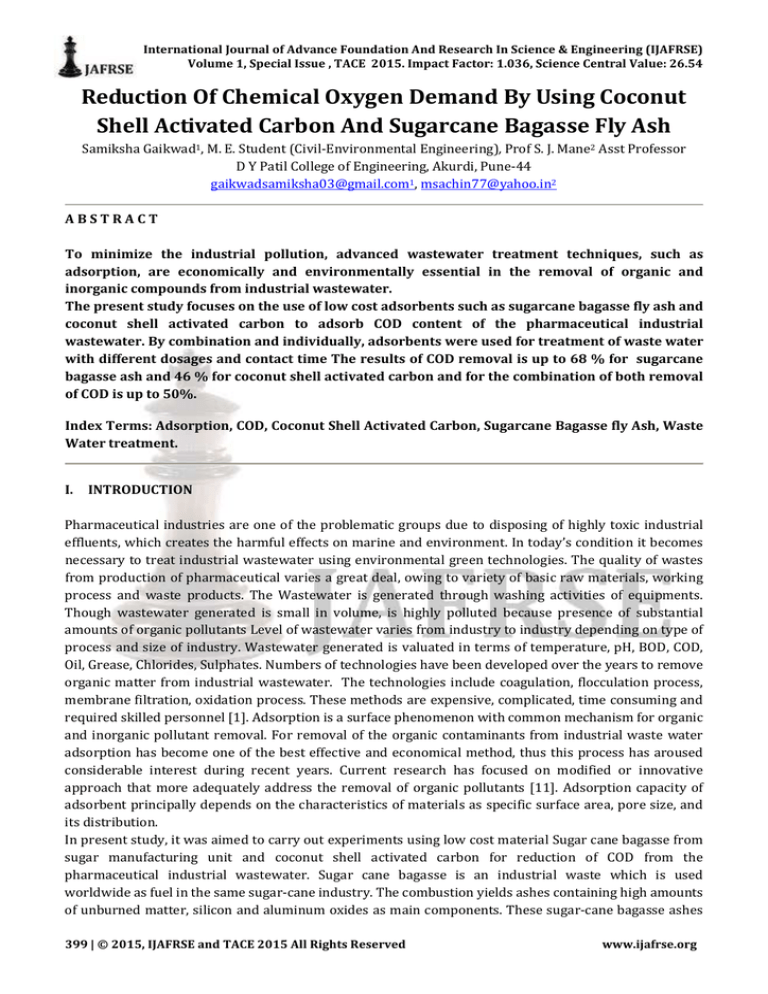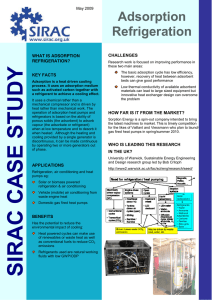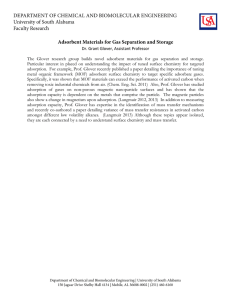
International Journal of Advance Foundation And Research In Science & Engineering (IJAFRSE)
Volume 1, Special Issue , TACE 2015. Impact Factor: 1.036, Science Central Value: 26.54
Reduction Of Chemical Oxygen Demand By Using Coconut
Shell Activated Carbon And Sugarcane Bagasse Fly Ash
Samiksha Gaikwad1, M. E. Student (Civil-Environmental Engineering), Prof S. J. Mane2 Asst Professor
D Y Patil College of Engineering, Akurdi, Pune-44
gaikwadsamiksha03@gmail.com1, msachin77@yahoo.in2
ABSTRACT
To minimize the industrial pollution, advanced wastewater treatment techniques, such as
adsorption, are economically and environmentally essential in the removal of organic and
inorganic compounds from industrial wastewater.
The present study focuses on the use of low cost adsorbents such as sugarcane bagasse fly ash and
coconut shell activated carbon to adsorb COD content of the pharmaceutical industrial
wastewater. By combination and individually, adsorbents were used for treatment of waste water
with different dosages and contact time The results of COD removal is up to 68 % for sugarcane
bagasse ash and 46 % for coconut shell activated carbon and for the combination of both removal
of COD is up to 50%.
Index Terms: Adsorption, COD, Coconut Shell Activated Carbon, Sugarcane Bagasse fly Ash, Waste
Water treatment.
I.
INTRODUCTION
Pharmaceutical industries are one of the problematic groups due to disposing of highly toxic industrial
effluents, which creates the harmful effects on marine and environment. In today’s condition it becomes
necessary to treat industrial wastewater using environmental green technologies. The quality of wastes
from production of pharmaceutical varies a great deal, owing to variety of basic raw materials, working
process and waste products. The Wastewater is generated through washing activities of equipments.
Though wastewater generated is small in volume, is highly polluted because presence of substantial
amounts of organic pollutants Level of wastewater varies from industry to industry depending on type of
process and size of industry. Wastewater generated is valuated in terms of temperature, pH, BOD, COD,
Oil, Grease, Chlorides, Sulphates. Numbers of technologies have been developed over the years to remove
organic matter from industrial wastewater. The technologies include coagulation, flocculation process,
membrane filtration, oxidation process. These methods are expensive, complicated, time consuming and
required skilled personnel [1]. Adsorption is a surface phenomenon with common mechanism for organic
and inorganic pollutant removal. For removal of the organic contaminants from industrial waste water
adsorption has become one of the best effective and economical method, thus this process has aroused
considerable interest during recent years. Current research has focused on modified or innovative
approach that more adequately address the removal of organic pollutants [11]. Adsorption capacity of
adsorbent principally depends on the characteristics of materials as specific surface area, pore size, and
its distribution.
In present study, it was aimed to carry out experiments using low cost material Sugar cane bagasse from
sugar manufacturing unit and coconut shell activated carbon for reduction of COD from the
pharmaceutical industrial wastewater. Sugar cane bagasse is an industrial waste which is used
worldwide as fuel in the same sugar-cane industry. The combustion yields ashes containing high amounts
of unburned matter, silicon and aluminum oxides as main components. These sugar-cane bagasse ashes
399 | © 2015, IJAFRSE and TACE 2015 All Rights Reserved
www.ijafrse.org
International Journal of Advance Foundation And Research In Science & Engineering (IJAFRSE)
Volume 1, Special Issue , TACE 2015. Impact Factor: 1.036, Science Central Value: 26.54
(SCBA) have been chemically, physically and mineralogically characterized, in order to evaluate the
possibility of their use as a cement replacing material in the concrete industry and as an adsorbent in
surface chemistry [11]. Coconut shells litter around streets they constitute environmental nuisance. It is
anticipated that, this work would abate the environmental nuisance if the coconut shell are been
processed into granulated activated carbon (GAC) for the removal of different contaminants likely to be
encountered in industrial wastewater. Hence, agricultural wastes such as coconut shell sugarcane
bagasse could be important for the removal of contaminants in wastewater.
The objectives of this study were to compare the adsorption efficiency of coconut shell based activated
carbon and sugarcane bagasse fly ash in the treatment of a pharmaceutical industrial wastewater for the
reduction of COD.
II. MATERIALS AND METHODOLOGY
A. ADSORBENT COLLECTION
During the production of Sugar, bagasse Fly ash is obtained as a waste product in large quantities from
Sugar mill. The total amount and physico-chemical characteristics of Fly ash which is occurred on
burning Bagasse generated in boiler varies from boiler to boiler depending upon the boiler’s efficiency.
Bagasse Fly ash used in present research work is collected from Rajgad Sahkari Sakhar Karkhana ltd.,
Anantnagar-Nigde, Bhor, Dist-Pune, Pune, and Maharashtra. For series of experiments, it was washed to
remove excess fines and oven dried at 1000C for 24 hours before its use in experiments. It is light black
colored material. Bagasse Fly ash mainly consists of unburned carbon, SiO2 - 51 to 55%, Al2O3 – 10 to
11%, CaO -5 to 6 %, Fe2O3 - 4 to 5%, and trace of MgO.
Granular activated carbon manufactured from Coconut shell is designed for reduction of tastes, odors and
dissolved organic chemicals from municipal and industrial water supplies. It is manufactured from select
grades of coconut shell coal to produce a high density, durable granular product. Activated carbon
manufactured from coconut shell is considered superior to those obtained from other sources mainly
because of small macro pores structure which renders it more effective for the adsorption of gas/vapour
and for the removal of colour and odour of compounds. Coconut shell activated carbon is black in colour,
mainly consists of, pH 7-10, Moisture content < 5%, Ash content < 8%, Mean particle diameter 1.2 – 1.4
mm, Iodine Number 500 mg/g, Hardness value 99%.
B. SAMPLING
Sampling was done using standard method from a pharmaceutical industry situated in the Ranjangaon
MIDC. Samples were collected from industrial outlet in plastic bottles and then preserved at 4˚C. The
experiments were carried out in batch mode for measurement of adsorption capacities. By combination
and individually, adsorbents CSAC and SBFA were used for treatment of waste water with different
dosages and contact time. The known quantity (250 ml) of sample was treated with different amount of
Coconut shell Activated Carbon and Sugarcane bagasse fly ash viz 1, 1.5, 2, 2.5, 3, 3.5 gm/ml, stirred well
and kept in contact for 24 hours at room temperature. Then the samples were filtered and analyzed
especially for COD removal. The method for determination of COD used is dichromate reflux method.
C. TESTING PARAMETERS
COD was estimated before and after addition of adsorbents.
400 | © 2015, IJAFRSE and TACE 2015 All Rights Reserved
www.ijafrse.org
International Journal of Advance Foundation And Research In Science & Engineering (IJAFRSE)
Volume 1, Special Issue , TACE 2015. Impact Factor: 1.036, Science Central Value: 26.54
D. ADSORPTION ISOTHERM
The adsorption experiments were carried out by batch method. Percentage of removal of COD
concentration calculated by following equation:
Removal % = (C0– C) /C0 x 100
Where C0 is the initial concentration of COD (mg L-1) of the wastewater sample and C is the final
concentration of COD (mg L-1) after addition of adsorbent.
An adsorption isotherm is the presentation of the amount of solute adsorbed per unit weight of
adsorbent as a function of the equilibrium concentration in the bulk solution at constant temperature.
Langmuir and Freundlich adsorption isotherms are commonly used for the description of adsorption
data.
The Langmuir equation is expressed as:
Ce
1
=
qe
+
bXm
Ce
- - - Langmuir
Xm
Where Ce is the equilibrium concentration of solute (mmol L−1), qe is the amount of solute adsorbed per
unit weight of adsorbent (mmol g−1 of clay), Xm is the adsorption capacity
(mmol g−1), or monolayer capacity, and b is a constant (L mmol−1 ).
The Freundlich isotherm describes heterogeneous surface adsorption. The energy distribution for
adsorptive sites (in Freundlich isotherm) follows an exponential type function which is close to the real
situation. The rate of adsorption/desorption varies with the strength of the energy at the adsorptive
sites. The Freundlich equation is expressed as:
Logqe = log k + 1 / n logCe
- - - Freundlich
Where k (mmol g−1) and 1/n are the constant characteristics of the system.
III. RESULTS AND DISCUSSION
Various dosages of the Coconut shell activated carbon and Sugarcane bagasse fly ash were used to treat
the industrial wastewater. The COD concentration is reduces as we increased the adsorbent dosage. The
effects of adsorbent dosage were varied from 1, 1.5, 2, 2.5, 3, 3.5 gm/ml for Coconut shell activated
carbon and Sugarcane bagasse fly ash individually. Hence 3.5 gm/ml was found to give maximum value of
COD in treating the wastewater. By using 3.5 gm/ml as optimum dose contact time was varied and tested
for after 30, 60, 90, 120, 150 min respectively. Removal efficiency was calculated and graph was plotted.
Following graph shows the reduction in COD concentration after adding adsorbent dosages.
A. Effect of Adsorbent Dosage
Following graph shows reduction of COD concentration after increasing the adsorbent dosage. As we
increase adsorbate dosage more than the optimum the increase in adsorption is very less and it becomes
401 | © 2015, IJAFRSE and TACE 2015 All Rights Reserved
www.ijafrse.org
International Journal of Advance Foundation And Research In Science & Engineering (IJAFRSE)
Volume 1, Special Issue , TACE 2015. Impact Factor: 1.036, Science Central Value: 26.54
cost ineffective. Figure no. 1, 2, 3 respectively shows effect on reduction of COD after increasing the
dosage of adsorbents.
B. Effect of contact time
Adsorption tends to increase with contact time. At first the increase in adsorption is very rapid as there
are lots of free sites for the adsorption to take place. Rate of adsorption decreases at later stages till
saturation is reached due to saturation of active sites. The optimum contact time for equilibrium was
found to be 150 min. Fig no. 4, 5, 6 shows effect on reduction of COD by varying contact time.
Fig. 1 Reduction of COD concentration using
CASC with various dosages
Fig. 2 Reduction of COD concentration using
SBFA with various dosages
Fig. 3 Reduction of COD concentration using
CSAC and SBFA with proportion 1:2
Fig. 4 Effect of contact time on reduction of
COD after adding CSAC (gm/ml)
Fig. 5 Effect of Contact time on Reduction of COD
After adding SBFA (gm/ml)
402 | © 2015, IJAFRSE and TACE 2015 All Rights Reserved
Fig. 6 Effect of Contact time on Reduction of
COD after adding Combination of
www.ijafrse.org
International Journal of Advance Foundation And Research In Science & Engineering (IJAFRSE)
Volume 1, Special Issue , TACE 2015. Impact Factor: 1.036, Science Central Value: 26.54
CSAC and SBFA
IV. CONCLUSION
Reduction of COD from wastewater using Coconut shell activated carbon and Sugarcane bagasse fly ash
as adsorbents has been experimentally determined and the following observations are made:
This study leads us to the conclusion that, efficient techniques for the removal of highly toxic organic
compounds from water and wastewater have drawn significant interest. Adsorption is recognized as an
effective and low cost technique for the removal of organic pollutants from water and wastewater, and
produce high-quality treated effluent. The wastewater of pharmaceutical industry is highly polluted
having higher COD value as adsorbent dose increases adsorption increases due to the availability of free
sites. Coconut shell activated carbon gives maximum reduction efficiency constant time than sugarcane
bagasse fly ash and combination of both the adsorbents. The problems will arises regarding the disposal
of exhausted adsorbent can be solved either by activation or incineration or disposal after proper
treatments.
V. REFERENCES
[1]
Vinesh V. Rakholiya and S. A. Puranik, “COD reduction using modifying industrial effluent
treatment flowsheet and low cost adsorbent as a part of cleaner production”, Advances in Applied
Science Research, vol. 3(3), pp. 1279-129, 2012
[2]
Sheetal s Karale & Mayur M Suryavanshi, “Dairy wastewater treatment using coconut shell
activated carbon & laterite as low cost adsorbents”, International Journal of Civil, Structural,
Environmental and Infrastructure Engineering Research and Development (IJCSEIERD), vol. 4, pp.
9-14, Apr 2014
[3]
Sunil J. Kulkarni1, Ajaygiri K. Goswami, “Adsorption Studies for Organic Matter Removal from
Wastewater by Using Bagasse Flyash in Batch and Column Operations”, International Journal of
Science and Research (IJSR), Volume 2 Issue 11, pp. 180-183, November 2013
[4]
Ahmad Ashfaq and Amna Khatoon, “Evaluating toxicological effects, pollution control and
wastewater management in pharmaceutical industry”, International Journal of Current Research
and Academic Review of vol. 2, pp. 54-65, July-2014
[5]
Krunal S. Ramanandi, Dr. S A Puranik, “Comparative Analysis of Adsorption Efficiency Using Low
Cost Adsorbents for COD Removal of Dye Intermediate (DASDA) Industrial Waste water”,
International Journal of Engineering Science and Innovative Technology (IJESIT), Vol 2, pp. 86-95,
May 2013
[6]
Abdul Karim Shah, Zeenat Muhammad Ali, Abdul Jabbar Laghari, and Syed Farman Ali Shah,
“Utilization of Fly Ash as Low-Cost Adsorbent for the Treatment of Industrial Dyes Effluents- A
Comparative Study”, Research and Reviews: Journal of Engineering and Technology, vol. 2, pp. 110, Jan – March, 2013
[7]
Odedara Shila M., Dr.S.A.Puranik, “COD Reduction by Adsorption in Dyes & Dyes Intermediate
Industry”, International Journal of Scientific Engineering and Technology, Vol. 1, pp 41-46, 01 July
2012
403 | © 2015, IJAFRSE and TACE 2015 All Rights Reserved
www.ijafrse.org
International Journal of Advance Foundation And Research In Science & Engineering (IJAFRSE)
Volume 1, Special Issue , TACE 2015. Impact Factor: 1.036, Science Central Value: 26.54
[8]
Lakdawala M.M. and Lakdawala J.M., “Comparative Study of Effect of PAC and GAC on Removal of
COD Contributing Component of Sugar Industry waste water”, Research Journal of Recent
Sciences, Vol. 2, pp 90-97, 2013
[9]
S.A. Puranik and A.K.A. Rathi, “Chemical Industry Waste water Treatment Using Adsorption” ,
journal of scientific & Industrial Research, vol. 61, pp. 53-60, January 2002
[10]
S. S. Turkar, D. B. Bharti and G. S. Gaikwad, “Various methods involved in waste water treatment
to control water pollution”, Journal of Chemical and Pharmaceutical Research, vol. 3(2), pp. 58-65,
2011
[11]
Milan. M. Lakdawala and Yogesh. S. Patel, “The effect of low cost material Bagasse Fly ash to the
removal of COD Contributing component of combined waste water of Sugar Industry”, Archives of
Applied Science Research, vol. 4 (2), pp. 852-857, 2012
[12]
Amuda O.S. and Ibrahim A.O., “Industrial wastewater treatment using natural material as
adsorbent”, African Journal of Biotechnology, vol. 5 (16), pp. 1483-1487, 17 August 2006
[13]
Sunil J. Kulkarni, “Removal of organic matter from domestic waste water by adsorption”,
International Journal of Science, Engineering and Technology Research (IJSETR), Vol 2, Issue 10,
pp. 1836-1839, October 2013
[14]
B. Shah, R. Tailor and A. Shah, “Adoptation of bagasse flyash a sugar industry solid waste into
zeolitic material for the uptake of phenol”, Env. Progress and Sustainable Energy, vol. 30(3), pp.
358 – 367, 2011
[15]
Sunil J. Kulkarni, Suhas V Patil, and Y. P. Bhalerao, “Flyash Adsorption Studies for Organic Matter
Removal Accompanying Increase in Dissolved Oxygen”, International Journal of Chemical
Engineering and Applications, vol. 2, pp. 434-438, December 2011
[16]
Sachin M.Kanawade, R.W.Gaikwad & S.A.Misal, “Low cost Sugarcane Bagasse Ash as an Adsorbent
for Dye Removal from Dye Effluent”, International Journal of Chemical Engineering and
Applications, Vol. 1, No. 4, pp. 309-318, December 2010
[17]
R. B. Parmar, R. S. Patel, K. P. Mistry, “Review on wastewater effluents from pharmaceutical
companies”, Indian Journal of Applied Research, vol. 5, pp. 221-223, Feb 2015
404 | © 2015, IJAFRSE and TACE 2015 All Rights Reserved
www.ijafrse.org






